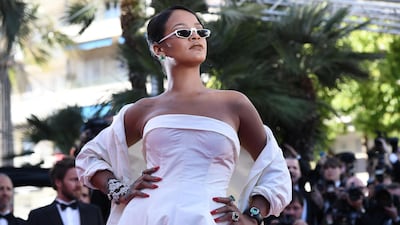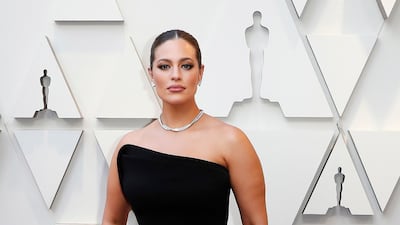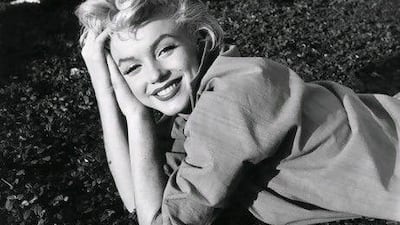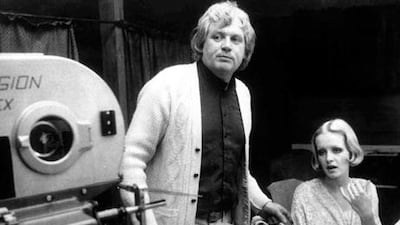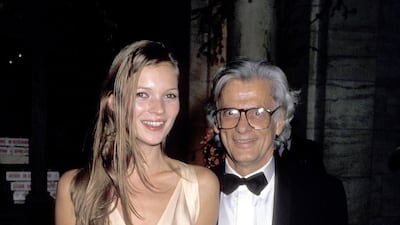"Beauty is not a matter of clothing size, it is a state of mind, an attitude – that certain something that makes each woman enchanting and unique," Dolce & Gabbana said in a statement this week. The brand was announcing that it would be extending the sizing across its collections to cater to a fuller figure.
It's been a good week for body diversity. An email from the Dubai modelling agency MA Models landed in my inbox, outlining its growing roster of "curvy" models. Ashley Graham, the model and body-acceptance crusader, has been unashamedly flashing her cellulite while on holiday in Morocco. Rihanna further established herself as a champion of women of all shades and sizes when she presented her Fenty clothing collection on mannequins that were shaped like actual women – curvaceous hips, slightly protruding tummies and all.
In a recent interview with British Vogue, the Barbadian songstress and entrepreneur made a remarkable admission: "I actually have had the pleasure of a fluctuating body type, where one day I can literally fit into something that is body-con, and then the next day – the next week – I need something oversize," she said.
I have suffered a similar fate my whole life – my weight regularly yo-yos by up to 10 kilograms and my body-con days are long gone – but I have never viewed this as a “pleasure”. I have, for as long as I can remember, considered it a curse, a lifelong battle to be fought at every mealtime and in every excruciating session at the gym.
I try to remind myself that, as my colleague Sarah Maisey outlined earlier this week, definitions of attractiveness have evolved with the ages. Marilyn Monroe’s curvy UK size 12 silhouette was once the height of femininity. When I was a teenager in the 1990s, it was Kate Moss’s semi-emaciated frame that was setting the standard for the ideal female form (along with her assertions that “nothing tastes as good as skinny feels”). This evolving perception of beauty is something that fitness blogger Cassey Ho cleverly illustrated in a series of Instagram posts last year, when she doctored her body shape to show what would have been considered attractive during various stages of history. Perhaps I should have been born during the Italian Renaissance, when, according to Ho, “looking full with a rounded stomach, large hips and an ample blossom [was] in. Being well fed [was] a sign of wealth and status.”
What is considered attractive can also be highly cultural. In certain parts of the world, a curvaceous figure is still appealing, whereas the western ideal tends to favour an almost unattainable Victoria's Secret-style leanness. One of the benefits of living in Dubai is that, by nature of its diversity, it is home to endless permutations of female beauty. Of course, there are still plenty of carefully curated, gym-honed physiques around, but there is much more besides.
One of the dangers of an increasingly interconnected world is that perceptions of beauty become homogenised. A scroll through your Instagram feed will confirm that more and more women are aspiring to a Kardashian-esque standard of beauty, and an upsurge in specific types of plastic surgery reaffirms that the disproportionate hourglass is fast-becoming the body shape du jour.
But as Rihanna, Dolce & Gabbana and the likes of Ashley Graham are proving, beauty comes in infinite forms. Now I just need to train my own brain to see my fluctuating weight as “enchanting” and “unique”.
Electric scooters: some rules to remember
- Riders must be 14-years-old or over
- Wear a protective helmet
- Park the electric scooter in designated parking lots (if any)
- Do not leave electric scooter in locations that obstruct traffic or pedestrians
- Solo riders only, no passengers allowed
- Do not drive outside designated lanes
COMPANY%20PROFILE%20
%3Cp%3EName%3A%20DarDoc%3Cbr%3EBased%3A%20Abu%20Dhabi%3Cbr%3EFounders%3A%20Samer%20Masri%2C%20Keswin%20Suresh%3Cbr%3ESector%3A%20HealthTech%3Cbr%3ETotal%20funding%3A%20%24800%2C000%3Cbr%3EInvestors%3A%20Flat6Labs%2C%20angel%20investors%20%2B%20Incubated%20by%20Hub71%2C%20Abu%20Dhabi's%20Department%20of%20Health%3Cbr%3ENumber%20of%20employees%3A%2010%3C%2Fp%3E%0A
UAE currency: the story behind the money in your pockets
more from Janine di Giovanni
The candidates
Dr Ayham Ammora, scientist and business executive
Ali Azeem, business leader
Tony Booth, professor of education
Lord Browne, former BP chief executive
Dr Mohamed El-Erian, economist
Professor Wyn Evans, astrophysicist
Dr Mark Mann, scientist
Gina MIller, anti-Brexit campaigner
Lord Smith, former Cabinet minister
Sandi Toksvig, broadcaster
DC%20League%20of%20Super-Pets
%3Cp%3EDirector%3A%20Jared%20Stern%3C%2Fp%3E%0A%3Cp%3EStarring%3A%20Dwayne%20Johnson%2C%20Kevin%20Hart%2C%20John%20Krasinski%2C%20Keanu%20Reeves%2C%20Olivia%20Wilde%2C%20Kate%20McKinnon%2C%20Jameela%20Jamil%3C%2Fp%3E%0A%3Cp%3ERating%3A%203%2F5%3C%2Fp%3E%0A
Ten tax points to be aware of in 2026
1. Domestic VAT refund amendments: request your refund within five years
If a business does not apply for the refund on time, they lose their credit.
2. E-invoicing in the UAE
Businesses should continue preparing for the implementation of e-invoicing in the UAE, with 2026 a preparation and transition period ahead of phased mandatory adoption.
3. More tax audits
Tax authorities are increasingly using data already available across multiple filings to identify audit risks.
4. More beneficial VAT and excise tax penalty regime
Tax disputes are expected to become more frequent and more structured, with clearer administrative objection and appeal processes. The UAE has adopted a new penalty regime for VAT and excise disputes, which now mirrors the penalty regime for corporate tax.
5. Greater emphasis on statutory audit
There is a greater need for the accuracy of financial statements. The International Financial Reporting Standards standards need to be strictly adhered to and, as a result, the quality of the audits will need to increase.
6. Further transfer pricing enforcement
Transfer pricing enforcement, which refers to the practice of establishing prices for internal transactions between related entities, is expected to broaden in scope. The UAE will shortly open the possibility to negotiate advance pricing agreements, or essentially rulings for transfer pricing purposes.
7. Limited time periods for audits
Recent amendments also introduce a default five-year limitation period for tax audits and assessments, subject to specific statutory exceptions. While the standard audit and assessment period is five years, this may be extended to up to 15 years in cases involving fraud or tax evasion.
8. Pillar 2 implementation
Many multinational groups will begin to feel the practical effect of the Domestic Minimum Top-Up Tax (DMTT), the UAE's implementation of the OECD’s global minimum tax under Pillar 2. While the rules apply for financial years starting on or after January 1, 2025, it is 2026 that marks the transition to an operational phase.
9. Reduced compliance obligations for imported goods and services
Businesses that apply the reverse-charge mechanism for VAT purposes in the UAE may benefit from reduced compliance obligations.
10. Substance and CbC reporting focus
Tax authorities are expected to continue strengthening the enforcement of economic substance and Country-by-Country (CbC) reporting frameworks. In the UAE, these regimes are increasingly being used as risk-assessment tools, providing tax authorities with a comprehensive view of multinational groups’ global footprints and enabling them to assess whether profits are aligned with real economic activity.
Contributed by Thomas Vanhee and Hend Rashwan, Aurifer
COMPANY%20PROFILE
%3Cp%3E%3Cstrong%3EName%3A%20%3C%2Fstrong%3EEjari%3Cbr%3E%3Cstrong%3EBased%3A%20%3C%2Fstrong%3ERiyadh%2C%20Saudi%20Arabia%3Cbr%3E%3Cstrong%3EFounders%3A%20%3C%2Fstrong%3EYazeed%20Al%20Shamsi%2C%20Fahad%20Albedah%2C%20Mohammed%20Alkhelewy%20and%20Khalid%20Almunif%3Cbr%3E%3Cstrong%3ESector%3A%20%3C%2Fstrong%3EPropTech%3Cbr%3E%3Cstrong%3ETotal%20funding%3A%20%3C%2Fstrong%3E%241%20million%3Cbr%3E%3Cstrong%3EInvestors%3A%20%3C%2Fstrong%3ESanabil%20500%20Mena%2C%20Hambro%20Perks'%20Oryx%20Fund%20and%20angel%20investors%3Cbr%3E%3Cstrong%3ENumber%20of%20employees%3A%20%3C%2Fstrong%3E8%3C%2Fp%3E%0A
BIG SPENDERS
Premier League clubs spent £230 million (Dh1.15 billion) on January transfers, the second-highest total for the mid-season window, the Sports Business Group at Deloitte said in a report.
Takreem Awards winners 2021
Corporate Leadership: Carl Bistany (Lebanon)
Cultural Excellence: Hoor Al Qasimi (UAE)
Environmental Development and Sustainability: Bkerzay (Lebanon)
Environmental Development and Sustainability: Raya Ani (Iraq)
Humanitarian and Civic Services: Women’s Programs Association (Lebanon)
Humanitarian and Civic Services: Osamah Al Thini (Libya)
Excellence in Education: World Innovation Summit for Education (WISE) (Qatar)
Outstanding Arab Woman: Balghis Badri (Sudan)
Scientific and Technological Achievement: Mohamed Slim Alouini (KSA)
Young Entrepreneur: Omar Itani (Lebanon)
Lifetime Achievement: Suad Al Amiry (Palestine)
